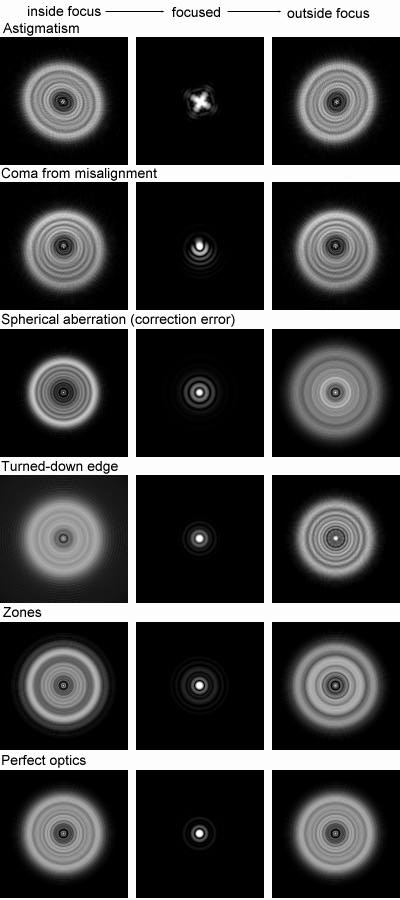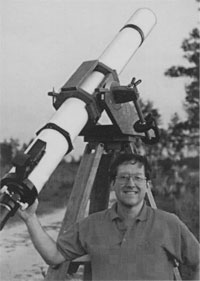Index of Books We Recommend
![]() Pricing
Pricing

"Star Testing Astronomical Telescopes: A Manual for Optical Evaluation and Adjustment"
by Harold Richard Suiter
Hardcover - 376 pages, Published December 1994
Willmann-Bell, Inc. publishers; ISBN: 0943396441
Dimensions (in inches): 9.25 x 6-1/4 x 1/2
Other Available Editions: None
|
"Star Testing Astronomical Telescopes" is among those few up to date books which Company Seven recommends to those persons who have decided to buy an astronomical telescope, or for those who are now considering the choice of astronomical telescope. This is a book which can be most helpful when you receive a new telescope. It will teach you how to determine if your new telescope has an optical gross anomaly that should justify its return for an exchange. And since most telescopes are roughly handled during shipping and they often arrive out of proper alignment, "Star Testing Astronomical Telescopes" teaches one how identify if a telescope is out of adjustment ("collimation"), and it will provide insights into how to remedy it.
This book is a remarkable accomplishment. Previously there were no books that were affordable by most amateurs, and which could be understood by anyone less than a College mathematics expert on this subject. Not that all of the content in this book will be understood by everybody, but the concepts and what one should look to see in a telescope are readily understood by the typical enthusiast. Anyone from about High School age and older should find the book readable, interesting, and informative. "Star Testing Astronomical Telescopes" is concise, and well illustrated. However, this is not light or casual reading; one needs to read it carefully, and maybe a few times in order to grasp the large quantity of information provided. This remains one of a very few titles that discusses those optical systems that an amateur or small college are likely to encounter. And it's topics that are likely to remain relevant, even if the technology of lens designs changes somewhat over the forseeable future.
Caveat Emptor! This title has produced some unjustified customer concern and returns since it is possible for the casual reader to misunderstand some of the information. So please understand:
"Star Testing Astronomical Telescopes" is The Bible of telescope Star Testing testing and adjustment. It is a great choice for those who wish to better understand their telescopes, and possibly improve the performance of that telescope. When this book was introduced in 1994 it soon became "the book many telescope manufacturers do not want you to read" because it so readily could demonstrate the shortcomings and inconsistencies of many of the mass produced, amateur grade telescopes. Martin Cohen, Company Seven The Star Test Rather than narrowing the scope of the book to testing individual components, Suiter's focus of the book is a test method that can be used at the observing site, so that all the problems that impact on a telescope's performance can be diagnosed. The star test is such a method. It uses the entire working aperture and all the elements of a telescope. It is not a poor substitute or a work-around that uses bits and pieces of the optical system. It is the oldest and most sensitive of the optical tests—an inspection of the diffraction image itself. The Star Test is not new technology, it is an appropriate and discerning technique. The concepts of the Star Test were used as far back as 1722 when John Hadley used it when making the earliest astronomical Newtonian reflecting telescopes. Star-test results apply to the complete imaging performance of the telescope. The star test is lightning-fast and requires only a good high-power eyepiece. It tests the telescope for precisely what it was meant to do. Bad or poorly-aligned instruments fail the star test unambiguously. The star test often allows you to correct the optical difficulty immediately in the field, when you might be frantic to have your telescope perform well to observe a once in a lifetime event.

Above: Examples of Star Test diffraction pattern images from the book (37,161 bytes) While the star test has been around for centuries learning it has often been hampered by messy mathematics and its visual nature. Most people who use it have learned it at the elbow of a patient Master. In this book, Suiter becomes your Master. He carefully shields you from difficult diffraction theory and uses advanced computer generated graphics to show you the appearance of each aberration. Again and again, you will look at these graphics and say “I've seen that before. So that's what it was!” The star test is a powerful but inexpensive way of obtaining better resolution and contrast. With this book most observers will find that they don't need a new telescope because they now can test, diagnose and fix the one they have. Using "Star Testing Astronomical Telescopes" as a guide, your telescope will perform to the best of it's abilities and perhaps it will show images better than you would have believed possible. In Chapter 2 the author has a "condensed" Star Test Manual for those who want a quick start into testing. The following chapters go into more detail about fine points, and theory. For those who can not get a telescope out on enough good quality nights to Star Test, Suiter describes how to employ an artificial star that can be used at one's convenience. |
|
Foreword |
|
Price $29.95 (U.S.D.); please add $5.00 for domestic postage, or $10.00 for international postage.
The Author:
Harold Richard Suiter is an experimental physicist who has worked on such diverse topics as the energy levels in atoms, multi-particle decay reactions in nuclei, and scattering of sound from underwater structures. He became an avid binocular astronomer at age 11 since he was fortunate enough to see the Milky Way from his parents backyard in Hillsboro, Ohio. During his formative years, he acquired a taste for galactic clusters, dark nebulae, and loose stellar associations. He has been an amateur telescope maker since 1978, having completed a diverse array of instruments. And owning a broad range of other telescopes including an Astro-Physics Apo - one of very few new telescopes to provide a "textbook" perfect Star Test pattern. He has been affiliated with astronomy clubs including the Columbus Astronomical Society. Suiter currently observes from the tranquil yet hazy skies near Panama City, in northwest Florida. He holds a Ph.D. degree in physics from Ohio State University. |
Contents Copyright 1994-2002 Company Seven All Rights Reserved



 Richard Suiter with one of our with
Richard Suiter with one of our with